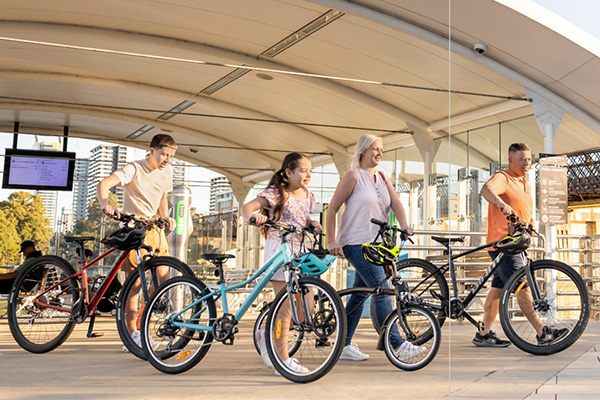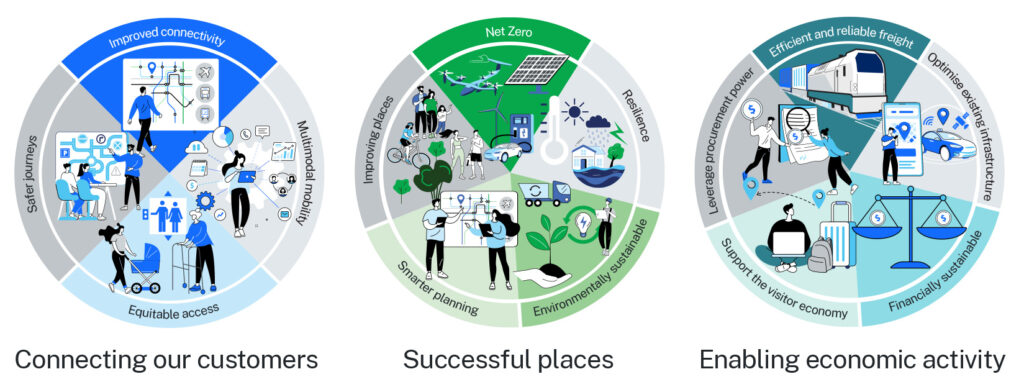The team at Bicycle NSW has taken a deep dive into the new Future Transport Strategy, attending an excellent presentation hosted by the Committee for Sydney and a webinar by Transport for NSW.
We thought our friends and Members would be interested to learn more about the strategic directions that will inform future transport planning. There is much to celebrate for advocates of walking and cycling. It is clear that the urgent need to move away from ‘car-first’ thinking is becoming more deeply embedded at every level of government.

A key ambition of the new Strategy is to support multi-modal transport options where customers can combine bike trips with public transport to reduce car reliance, even for long-distance trips (Image: TfNSW)
What has changed in NSW since 2018?
The strategy updates the 2018 Future Transport 2056 with some important new perspectives that reflect the social, political and economic upheavals of the last few years:
- The pandemic years saw huge growth in the use of technology to travel differently and travel less.
- The trend to remote working has shown how quickly people can adopt new habits. We can be more ambitious about encouraging behaviour change in transport choices to manage demand.
- Transport planning will no longer be focused on the 5-day work commute. New work patterns are here to stay and customers need access all day, 7 days a week.
- The pandemic highlighted how access to services and opportunities is not equal for all customers in all places.
- The 6 Cities Region has supplanted the Metropolis of Three Cities to guide regional planning.
- Fast rail is now seen as essential to connect the 6 cities and grow prosperity in regional NSW
- 15-minute neighbourhoods are a global trend that will develop the 30-minute city concept
- The Movement and Place framework was introduced in 2018 but it is now fully embedded in Transport for NSW policy.
- Important policies that support active transport infrastructure were released in 2021 – Road User Space Allocation, Providing for Walking and Cycling in Transport Projects, the Walking Space Guide and the Cycleway Design Toolbox.
- There is more urgency around reducing greenhouse gas emissions. Transport for NSW has made a commitment to Net Zero for transport operations by 2035 and it is clear that EVs will not be enough!
- Bushfires and floods have demonstrated the need to build resilient multi-modal transport systems.
- Improvements in trip mapping and ticketing technology have enabled customers to be more comfortable choosing the best mode for a trip and switching between modes.
- Connecting with Country now informs the planning, design, and delivery of built environment projects in NSW
- There is bipartisan recognition that transport infrastructure can make tangible improvements to place– the Bourke Street cycleway and the George Street light rail are great examples!
- The growing freight load was evident during the pandemic and steady growth is expected as consumer demand for goods increases with population.
- Micromobility in the form of e-bikes and e-scooters has exploded. Emerging modes need to be considered in the road environment. E-cargo bikes are an accelerating global trend to make cities breathable and walkable.
Key outcomes

Pictorial summaries of the three primary outcomes that the new Future Transport Strategy
aspires to achieve (Source: TfNSW)
The Future Transport Strategy strives for three overarching outcomes: Connecting our customers’ whole lives; Successful places for communities; and enabling economic activity
It sets 14 strategic directions, a suite of joined-up measures that all need to work together to deliver the outcomes.
What is in it for bicycle riders?
The importance of walking and cycling is highlighted in every section of the Strategy. There are active transport goals under most of the 14 directions. This is a summary of the promises Bicycle NSW found most exciting:
- Sustainable modes will be prioritised in every planning and land use decision. Walking, cycling, micromobility and public transport are the key to meeting Net Zero targets. Switching to electric cars will not get us close!
- Car-free mobility must be an option for most people for most trips. It is essential to reduce the 70% of trips under 2km that are taken in a car.
- Multi-modal mobility is key to support end-to-end journeys. There will be a focus on first- and last-mile solutions – that is, better facilities for walking and cycling!
- There will be record investment in walking and cycling infrastructure.
- Strategic cycleway corridors for each of the 6 Cities will be developed along with regional networks. The conceptual network for the Eastern Harbour City identifies 30 strategic cycleway corridors making up approximately 250km. This was released in April and the other plans will follow soon.
- Independent mobility for children must be enhanced – again, this means safe, protected walking and cycling infrastructure, lower traffic speeds and reduced traffic volumes.
- Greater Sydney’s traffic will be stabilised to ensure that population growth can occur without the city seizing up. The total vehicle-miles travelled must not increase. This won’t happen without enabling more walking and cycling!
- Existing infrastructure must be optimised. NSW will not keep building roads to ‘solve’ congestion. The focus will be on moving people and goods, not vehicles, recognising that the private car is the least efficient form of transport in terms of space and energy use.
- Streets will be managed primarily as public space where people can linger, walk and cycle. The speed and volume of traffic will need to decrease.
- Major projects will improve amenity on State roads, the arterial traffic sewers where movement has long been prioritised over place, even when they run through neighbourhood centres.
- Road space reallocation is essential and will underpin all future transport goals. Space must be taken back from cars to redress 70 years of car-first planning.
Road space reallocation
The clear intent to reconsider road space is highlighted by an exciting diagram under direction E2: Optimise existing infrastructure. The diagram shows how reconfiguring vehicle and parking lanes to prioritise more efficient vehicles gets more from existing assets. Bicycle and bus lanes will reduce the number of private vehicle trips and improve the liveability and vibrancy of our communities. Imagine the possibilities for your local arterial traffic sewer!

A key diagram from the new Future Transport Strategy that explicitly supports the reallocation of road space, comparing the total number of people moved per hour in the same amount of space on a car-oriented street and a multimodal street (Source: TfNSW)
These kinds of road space reallocation projects are beginning to happen in our car-loving state. The Princes Highway at Sydney Park Junction is being trimmed from 6 lanes to 4, with reduced speed limits, separated cycleways and safer pedestrian crossings. Our very supportive submission is here. Victoria Road in Rozelle is slated to be next in line for a makeover, following years of advocacy from Bicycle NSW and community groups.
Sadly, more suburban roads such as Kingsway in Sutherland are missing out, with plans to squeeze a shared path into pedestrian space while 6 wide vehicle lanes are left untouched.
Hopefully, we will soon see the end of narrow and impractical shared paths along arterial roads that compromise pedestrian safety and do nothing to challenge the dominance of private vehicles between the kerbs.
Next steps
Transport for NSW needs to set targets for mode shift and traffic stabilisation. The targets will be context specific and vary across different parts of the state. Without a goal to work towards, both state and local governments will be unfocused in efforts to reduce emissions and reclaim our public space for better things than car storage.
The strategic cycleway corridor networks for 5 of the 6 Cities are eagerly awaited, as are detailed plans for where exactly the cycleways will go. The Active Transport team under Minister Stokes has publicly stated that state roads will be used where possible. This is great as these roads are generally direct, level and desperately need road space to be diverted from vehicle lanes to meet objectives around amenity, emissions and equity.
And then funding! Budgets have increased but are still tiny compared with the resources thrown at road projects. Councils are hamstrung and desperately need money, skills and manpower to complete active transport networks and upgrades.
We congratulate Transport for NSW for putting out such a forward-thinking plan in the run up to an election.
However, it is important to walk the talk. Transport for NSW is a huge organisation. Unfortunately, new ideas about movement and place will take a long time to filter down through the levels of bureaucracy. Just two weeks after Future Transport was released, a proposal to ‘upgrade’ the Western Distributor has gone on exhibition. The project will widen off-ramps and intersections to increase the capacity of the Anzac Bridge, funnelling yet more traffic into the city and impeding plans to make more walkable and liveable precincts in Pyrmont and Ultimo. Our concerns are here. This is the polar opposite for the strategy to stabilise traffic, reallocate road space away from vehicles and prioritise place!
And on the north side of the Harbour, Transport for NSW is barrelling ahead with the Warringah Freeway ‘upgrade’ without a concrete plan to leverage really good outcomes for active transport from the Government investment. In fact, existing walking and cycling infrastructure is being removed! Read more here.
Bicycle NSW will continue to push back against car-first planning and remind TfNSW of its great strategies and policies to prioritise walking and cycling. Please support our advocacy work on active transport infrastructure across NSW by joining the Bicycle NSW family today.

